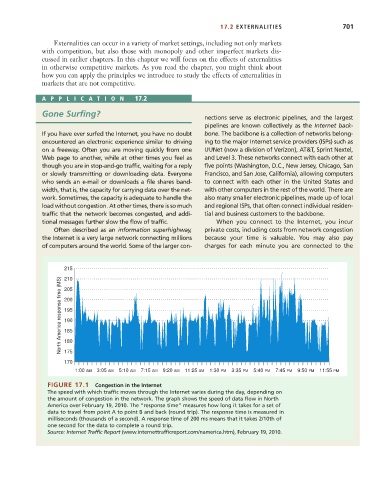Page 727 - Microeconomics, Fourth Edition
P. 727
c17ExternalitiesandPublicGoods.qxd 8/22/10 4:56 AM Page 701
17.2 EXTERNALITIES 701
Externalities can occur in a variety of market settings, including not only markets
with competition, but also those with monopoly and other imperfect markets dis-
cussed in earlier chapters. In this chapter we will focus on the effects of externalities
in otherwise competitive markets. As you read the chapter, you might think about
how you can apply the principles we introduce to study the effects of externalities in
markets that are not competitive.
APPLICA TION 17.2
Gone Surfing?
nections serve as electronic pipelines, and the largest
pipelines are known collectively as the Internet back-
If you have ever surfed the Internet, you have no doubt bone. The backbone is a collection of networks belong-
encountered an electronic experience similar to driving ing to the major Internet service providers (ISPs) such as
on a freeway. Often you are moving quickly from one UUNet (now a division of Verizon), AT&T, Sprint Nextel,
Web page to another, while at other times you feel as and Level 3. These networks connect with each other at
though you are in stop-and-go traffic, waiting for a reply five points (Washington, D.C., New Jersey, Chicago, San
or slowly transmitting or downloading data. Everyone Francisco, and San Jose, California), allowing computers
who sends an e-mail or downloads a file shares band- to connect with each other in the United States and
width, that is, the capacity for carrying data over the net- with other computers in the rest of the world. There are
work. Sometimes, the capacity is adequate to handle the also many smaller electronic pipelines, made up of local
load without congestion. At other times, there is so much and regional ISPs, that often connect individual residen-
traffic that the network becomes congested, and addi- tial and business customers to the backbone.
tional messages further slow the flow of traffic. When you connect to the Internet, you incur
Often described as an information superhighway, private costs, including costs from network congestion
the Internet is a very large network connecting millions because your time is valuable. You may also pay
of computers around the world. Some of the larger con- charges for each minute you are connected to the
215
North America response time (MS) 200
210
205
195
190
185
180
175
170
1:00 AM 3:05 AM 5:10 AM 7:15 AM 9:20 AM 11:25 AM 1:30 PM 3:35 PM 5:40 PM 7:45 PM 9:50 PM 11:55 PM
FIGURE 17.1 Congestion in the Internet
The speed with which traffic moves through the Internet varies during the day, depending on
the amount of congestion in the network. The graph shows the speed of data flow in North
America over February 19, 2010. The “response time” measures how long it takes for a set of
data to travel from point A to point B and back (round trip). The response time is measured in
milliseconds (thousands of a second). A response time of 200 ms means that it takes 2/10th of
one second for the data to complete a round trip.
Source: Internet Traffic Report (www.internettrafficreport.com/namerica.htm), February 19, 2010.

